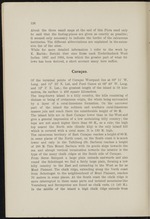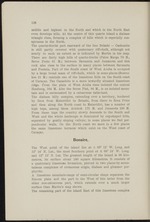| 1 |
 |
“...abbreviations are explained in the exten-
sive list of the sites.
While for more detailed information 1 refer to the work by
K. Martin: Bericht fiber eine Reise nach Niederlandisch West
Indien 1887 and 1888, from which the greater part of what fol-
lows has been derived, a short account many here suffice.
Curagao.
Of the terminal points of Curagao Westpunt lies at 69° 11' W.
Long, and 12° 23' N. Lat. and Punt Canon at 68° 49' W. Long,
and 12° 3' N. Lat.; the greatest length of the island is 58 kilo-
metres, its surface + 450 square kilometres.
The long-drawn island is a hilly country, the hills consisting of
diabase or being of cretaceous origin, the whole being surrounded
by a layer of a coral-limestone formation. On the narrower
part of the island the nothern and southern coral-limestone
masses join and reach there the considerable height of 90 M.
The inland hills are in East Curagao lower than in the West and
give a general impression of a low undulating hilly country; the
tops are not...”
|
|
| 2 |
 |
“...tops the country slowly descends to the South and
West and the whole landscape is dominated by cup-shaped hills,
separated by gently sloping valleys; in some places we find per-
pendicular walls. On the North coast we meet in a few places
the same limestone terraces which exist on the West coast of
Curagao.
Bonaire.
The West point of the island lies at ± 68° 12' W. Long, and
12° 14' N. Lat., the most Southern point at ± 68° 24' W. Long,
and 12° 13' N. Lat. The greatest length of the island is 36 kilo-
metres, its surface about 240 square kilometres. It consists of
a quaternary limestone formation, pierced in two places by moun-
tainous complexes of cretaceous origin, diabase and glimmer por-
phyrite.
A limestone mountain-range of semi-circular shape separates the
Rincon plain and the part to the West of this latter from the
other non-calcareous part, which extends over a much larger
surface than Martin’s map shows.
The remaining part of the island East of this limestone complex...”
|
|
